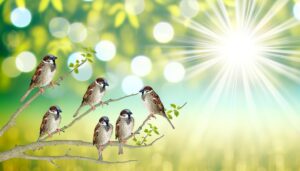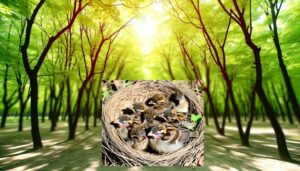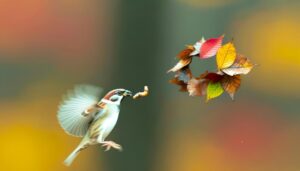Would the Meaning Be Deeper When Preferring a Sparrow Rather Than a Snail?
'I would rather be a sparrow than a snail' from Simon & Garfunkel's 'El Condor Pasa (If I Could)' captures a yearning for freedom and transformation. The sparrow, agile and sky-bound, symbolizes boundless possibilities and liberation.
In contrast, the snail, slow and earth-tethered, represents life's burdens and limitations. This metaphor speaks to our universal desire to soar above constraints and seek meaning beyond the mundane.
The tension between these symbols evokes deep emotional insight and reflects personal and cultural journeys. To truly grasp the depth of this sentiment, one must explore further.

Key Takeaways
- The phrase symbolizes a longing for freedom and a desire to transcend limitations.
- A sparrow represents agility, lightness, and the ability to soar above constraints.
- A snail signifies patience, burdens, and the slow, often arduous journey of life.
- The juxtaposition reflects the tension between aspirations for liberation and the reality of life's challenges.
- It encourages finding a balance between ambition and contentment in the pursuit of a fulfilling life.
Origins of the Phrase

The phrase 'I would rather be a sparrow than a snail' traces its roots back to the poignant lyrics of Simon & Garfunkel's song 'El Condor Pasa (If I Could),' capturing a yearning for freedom and transformation.
In this line, the sparrow symbolizes agility and boundless skies, while the snail embodies sluggishness and confinement. The imagery evokes a deep, emotional longing to transcend limitations and embrace life's expansive possibilities.
Listeners are drawn to the poetic juxtaposition, feeling a personal resonance with the desire to break free from life's mundane constraints. The metaphor speaks to the universal human experience—seeking liberation from the ordinary, aspiring to soar above the confines, and yearning for a life filled with more profound meaning and purpose.
Breakdown of Lyrics
In examining the lyrics, one finds a rich tapestry of symbolism that contrasts freedom and constraint, evoking a profound emotional response.
Each line carries a weight of yearning, where the sparrow's flight symbolizes liberation, while the snail's crawl evokes a life burdened by sluggishness.
The imagery invites the listener to reflect on their own desires and limitations, making the song a poignant exploration of human aspiration and struggle.
Symbolism in Lyrics
Every line of 'I'd rather be a sparrow than a snail' breathes life into a poignant metaphor, revealing a deep longing for freedom and transcendence over a sluggish, constrained existence.
The sparrow, a symbol of lightness and agility, embodies the spirit's desire to soar above life's mundane limitations.
In stark contrast, the snail, with its slow pace and heavy shell, represents burdens and inertia.
The lyrics paint a vivid picture of the human condition, torn between aspiration and stagnation.
The choice of these creatures isn't arbitrary; it encapsulates a universal yearning to break free from life's encumbrances.
This symbolism speaks to the heart, urging one to seek liberation and embrace the boundless possibilities of existence.
Emotional Impact Analyzed
When the lyrics declare, 'I'd rather be a sparrow than a snail,' they resonate deeply, evoking an emotional landscape where the soul yearns for liberation over the weight of life's burdens. The sparrow symbolizes lightness, freedom, and the ability to soar above earthly constraints, while the snail embodies sluggishness, vulnerability, and an encumbered existence. This juxtaposition stirs profound feelings, inviting listeners to reflect on their own desires for a life unshackled by limitations.
The sparrow's flight contrasts sharply with the snail's slow crawl.
The snail's exposed, fragile form highlights the desire for protection.
The sparrow's ability to rise symbolizes hope and dreams unbound.
This lyrical choice delivers a poignant, resonant message.
Symbolism of Sparrows

Sparrows, with their unchained wings, encapsulate the essence of freedom and unrestrained mobility. Their simple, joyous existence symbolizes the beauty found in life's uncomplicated moments, a stark contrast to the sluggish, burdensome nature of snails.
Freedom and Mobility
With their effortless flight and boundless energy, sparrows embody a sense of freedom and mobility that captures the human spirit's longing for liberation and adventure. Their ability to soar through the skies, unburdened by the constraints of the earth, speaks to an innate desire for movement and exploration.
Each fluttering wingbeat symbolizes a break from the monotony of daily life, evoking dreams of new horizons.
- Effortless Flight: Sparrows glide seamlessly, representing the ease and grace of unrestrained freedom.
- Boundless Energy: Their constant motion mirrors the restless human heart yearning for new experiences.
- Symbolic Liberation: Sparrows' flight signifies breaking free from limitations, inspiring a pursuit of one's aspirations.
In essence, sparrows remind us of the beauty in unconfined existence.
Joy and Simplicity
Their spirited flight not only symbolizes freedom but also captures the pure, unadorned joy and simplicity that sparrows bring to the world. These tiny birds, with their cheerful chirps, remind us of life's uncomplicated pleasures. They flit from branch to branch, embodying a carefree existence that contrasts sharply with human complexities. Sparrows teach us to find happiness in the small, everyday moments and to embrace simplicity over extravagance.
| Aspect | Sparrow Symbolism | Emotional Insight |
|---|---|---|
| Flight | Freedom and Joy | Embrace the moment |
| Song | Simple Pleasures | Find joy in the ordinary |
| Community | Unity and Support | Value connections over wealth |
Sparrows, in their humble presence, offer a profound lesson: joy and simplicity can coexist beautifully.
Symbolism of Snails
Unraveling the symbolism of snails reveals a profound connection to patience, resilience, and the slow but deliberate journey of life. Snails, with their unhurried pace, embody the essence of moving forward despite obstacles, teaching us the beauty of persistence.
Their fragile shells, both a home and a shield, symbolize the dual nature of vulnerability and protection. They remind us that progress isn't always swift but can still be meaningful.
- Patience: Snails illustrate the virtue of waiting and enduring.
- Resilience: Despite their delicate appearance, they persist through challenges.
- Journey: Their slow crawl signifies that every step, no matter how small, is part of a larger path.
In these creatures, one finds a poignant metaphor for life's enduring voyage.
Historical Context

In the tapestry of the 1960s, Simon & Garfunkel's song echoed the era's yearning for freedom and change.
The sparrow and snail became poignant symbols, reflecting society's struggle between liberation and inertia.
Through their melodic verses, the duo captured the emotional soul of a generation seeking to break free from the constraints of the past.
Simon & Garfunkel's Song
Simon & Garfunkel's 'El Condor Pasa (If I Could)' captures a poignant reflection on freedom and choice, set against the backdrop of the 1960s counterculture movement. The song's lyrical yearning—'I'd rather be a sparrow than a snail'—speaks to a desire for liberation and simplicity in an era of social upheaval. The metaphor resonates deeply, contrasting the grace of flight with the sluggishness of confinement. Listeners are invited to contemplate their own choices, questioning societal norms and personal aspirations.
- Evocative Imagery: The sparrow and snail symbolize contrasting life paths.
- Emotional Resonance: The lyrics stir a universal longing for freedom.
- Historical Context: Reflects the anti-establishment sentiments of the 1960s.
Simon & Garfunkel's harmonies amplify this timeless message.
1960s Cultural Impact
The 1960s, a decade filled with social revolutions and cultural transformations, breathed life into the metaphor of the sparrow and the snail. It became a powerful emblem of individual yearning and collective dissent. The sparrow, light and free, embodied the era's thirst for liberation. It echoed the cries of the civil rights movement, feminist wave, and counterculture explosion.
In stark contrast, the snail, slow and burdened, symbolized the weight of societal constraints and the inertia of traditional norms. This juxtaposition resonated deeply with a generation aiming to break free from rigid structures and seeking a life unbound by convention.
The metaphor captured the zeitgeist, encapsulating the collective desire for freedom, change, and the pursuit of a more meaningful existence.
Literary Interpretations
Many literary critics argue that the juxtaposition of a sparrow and a snail in the lyrics evokes a profound exploration of freedom versus confinement, urging readers to reflect on the inherent desire for liberation in the human spirit.
The sparrow, embodying flight and boundless skies, symbolizes the soul's yearning for freedom and transcendence. In contrast, the snail, with its heavy shell and grounded existence, represents life's burdens and the constraints that stifle the spirit's ascent. This vivid imagery resonates deeply, capturing the emotional struggle between aspiration and limitation.
- Sparrow: Symbol of freedom, lightness, and the boundless sky.
- Snail: Emblem of burden, confinement, and earthly ties.
- Juxtaposition: Highlights the tension between aspiration and limitation.
Psychological Perspectives

Delving into the psychological domain, the sparrow and snail metaphor encapsulates the internal conflict between an individual's innate longing for freedom and the oppressive weight of life's inherent responsibilities.
The sparrow, embodying freedom, soars effortlessly, symbolizing a soul's desire to live unburdened and unrestrained. In stark contrast, the snail, with its slow, burdened crawl, signifies the suffocating pressures and obligations that often tether individuals to mundanity.
This dichotomy reflects an emotional struggle, where one yearns to break free yet is persistently grounded by life's demands. The metaphor resonates deeply, stirring a poignant realization of this universal tension.
It speaks to the heart, urging introspection on the balance between aspirations and the realities that constrain them.
Cultural Significance
Drawing from this psychological tapestry, the sparrow and snail metaphor also weaves through various cultural narratives, symbolizing the universal human quest for liberation amidst life's relentless demands. Across cultures, the sparrow evokes imagery of freedom, flight, and grace, while the snail embodies sluggishness, burden, and confinement. This duality speaks to the human spirit's yearning to transcend limitations and embrace the boundless sky.
- In literature, sparrows often symbolize hope and renewal, while snails represent stagnation.
- In folklore, sparrows are seen as messengers of the divine, while snails are often tied to the earth, anchoring us to material concerns.
- In art, the contrast between sparrow and snail invites viewers to reflect on their own aspirations and constraints.
This cultural significance enhances our collective understanding.
Personal Reflections

In the quiet moments of introspection, one often finds a deep resonance with the sparrow's yearning for freedom over the snail's weighted existence.
The sparrow, embodying lightness and liberation, flits through the skies, embracing the boundless horizon with open wings. Its song, a melody of unrestrained joy, speaks to the soul's desire for unchained exploration and adventure.
In contrast, the snail, bound to the earth, carries its home as a burden, a constant reminder of its slow and laborious journey. This imagery invokes a profound reflection on one's own life choices—whether to soar with the sparrow's spirit or to remain anchored by the snail's constraints.
Each path offers lessons, yet the heart often yearns for the sparrow's flight.
Modern Relevance
Amid the hustle and bustle of modern life, the sparrow's quest for unencumbered freedom and the snail's deliberate pace each hold profound significance for contemporary souls managing the balance between aspiration and responsibility.
The sparrow embodies the spirit of liberation, a reminder to seize fleeting moments and cherish spontaneity. Contrastingly, the snail represents mindful perseverance, urging individuals to embrace patience and savor the journey. Both creatures reflect essential truths for those navigating the digital age's relentless pace.
- Freedom's allure: The sparrow inspires breaking free from societal constraints.
- Mindful living: The snail encourages embracing life's slower, meaningful rhythms.
- Personal balance: Both symbols guide finding harmony between ambition and contentment.
In their essence, these creatures offer timeless wisdom for today's world.
Broader Themes

Exploring deeper meanings, the metaphorical dance between the sparrow and the snail uncovers universal truths about freedom, patience, and the human experience.
The sparrow, with its effortless flight, symbolizes the yearning for liberation and the boundless possibilities of life's journey.
In contrast, the snail, grounded and slow, embodies the virtues of patience, persistence, and the acceptance of life's gradual unfolding.
This allegory invites reflection on personal aspirations and the diverse paths one might take.
Each creature's essence speaks to different facets of existence: the sparrow's song of adventurous spirit, the snail's lesson in enduring strength.
Together, they weave a poignant narrative that captures the tension and harmony inherent in the quest for a fulfilled life.
Conclusion
Essentially, the phrase 'I'd rather be a sparrow than a snail' paints a vivid tapestry of longing and choice. It encapsulates the yearning for freedom over stagnation, invoking the sparrow's flight as a symbol of boundless possibilities.
This metaphor resonates deeply, reminding us that, like the sparrow, we too can choose to soar above life's limitations, embracing the winds of change and the skies of potential. The message remains timeless, whispering to our hearts across generations.






